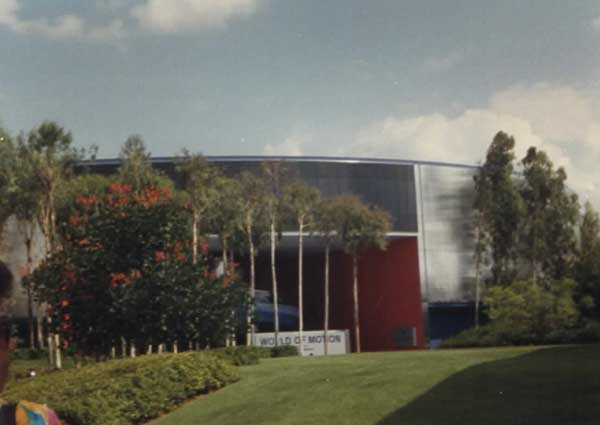
When guests first entered EPCOT Center in October 1982, they encountered a fully formed theme park. There were some glitches, but it was quite different from slimmer parks that followed in Florida and California under Michael Eisner. Horizons and Journey into Imagination opened in 1983 and quickly enhanced the offerings. You could spend a whole day and never leave Future World! This isn’t just a nostalgic view of past glories either. There was more to do in EPCOT Center’s early days.
A major factor in this situation was the longer ride times of the earlier attractions in Future World. They were largely slow-paced Omnimovers traveling deliberately through massive structures. A perfect example is World of Motion, a 15-minute journey though the history of transportation. It didn’t feel too long because that was a trend across the park. Here’s a sampling of ride times for some of Future World’s original attractions:
- Horizons – 15 minutes
- Journey Into Imagination – 11 minutes
- Spaceship Earth – 15 minutes
- World of Motion – 15 minutes
These numbers also don’t include the time you could spend at the ImageWorks, TransCenter, and other walk-through areas. For the sake of comparison, let’s take a look at the ride times for more recent attractions at EPCOT:
- Journey into Imagination with Figment – 5 minutes
- Mission: Space – 6 minutes
- Soarin’ – 4 minutes
- Test Track – 5 minutes
I recognize that this isn’t an apples-to-apples comparison. Simulators like Mission: Space can’t last for 15 minutes (no one wants that). However, these examples do indicate a shift in the way Disney approaches its parks. Even the Omnimovers have been shortened. At The Magic Kingdom, The Little Mermaid: Ariel’s Undersea Adventure is only six minutes long. So what changed? To put it simply, everything shifted. Disney isn’t the same company they were in the ‘70s. Attractions cost so much to build, and Disney trains guests to expect shorter experiences.
This analysis is far too simple, however. The Haunted Mansion and Pirates of the Caribbean (especially at Disneyland) are slow-moving rides that follow the old model yet are popular. Pirates has a lot in common with World of Motion. Both contain hordes of Audio-Animatronics, maintain a light tone, and are driven by a repetitive theme song. They also use the skills of Marc Davis, who developed some gags here to enhance Ward Kimball’s overall designs. Marc’s abilities to build a complex scene and set a mood stand out in both attractions. Davis’ involvement makes World of Motion closer to a classic Disney attraction than even Horizons or Imagination. Let’s take a closer look and discuss why World of Motion works so well.
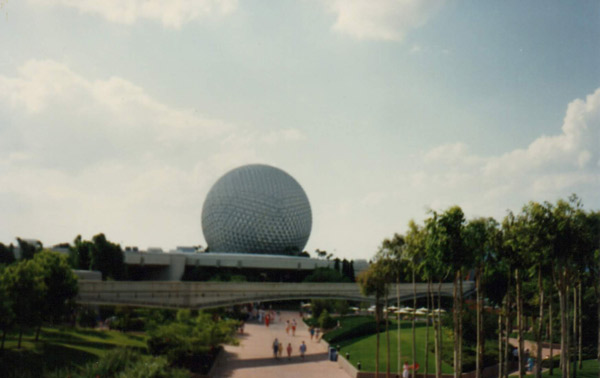
It’s Fun to Be Free
World of Motion begins with a nondescript queue that actually drew large lines in the early days. Visitors from the ‘90s probably have no memories of waiting in this queue. Resembling small automobiles, the blue vehicles helped create the right mood. After boarding the Omnimovers, we experience one of the cool views of Future World. The ride takes a brief circle around the front of the pavilion and gives an excellent photo shot for Spaceship Earth. This little touch makes the attraction feel like a forward-thinking transportation system. It’s a small glimpse at what life would be like in our future without needing our gas-guzzling cars.
From the start, we hear the familiar tune of “It’s Fun to Be Free”, which plays throughout the attraction. With music from Norman “Buddy” Baker and lyrics by X Atencio, the song perfectly matches the show’s tone. Different variations of the song play in the background and build an upbeat mood. World of Motion is a laid-back ride but sells the freedom of the open road. It’s wonderfully tongue-in-cheek but never in your face about it.
Gary Owens’ grandiose narration is regularly undercut by the sight gags in the ride. We begin the indoor portion by following cavemen’s feet as they light up along the wall. Owens speaks about foot power while we view an early man nursing a sore foot. In the next scene, he mentions test driving “many new models” while we see camels and other animals struggling with luggage. The constant jokes create pleasant vibes that differ from the idea that EPCOT Center was too educational. Very little about World of Motion is serious; history is secondary to laughs.
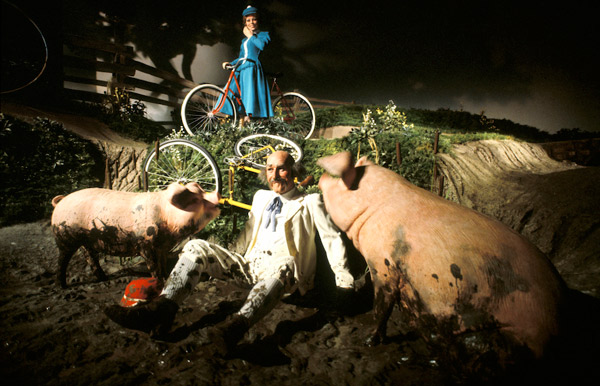
Now Things Really Get Rolling
Although fun is the star, World of Motion doesn’t skimp on special effects. Once the leaders pick the right wheel (sorry, triangle!), images of countless wheels fill the space above us. The clever mix of videos, animatronics, and sets in the next scenes flow so well. You might confuse a few scenes with parts of Spaceship Earth, but the tone is different. The shot of Leonardo da Vinci painting the Mona Lisa is played for comedy, not grandeur. That scene follows the postcard moment of a guy coming face to face with a sea creature. There are no dead zones in this ride.
Davis’ presence is felt with every new gag that undercuts Harris’ words. While he talks of steam and “progress on the open road”, we see a ram blocking a stagecoach. The sets are massive, including a giant paddle wheel boat and a train facing yet another barrier. It’s a large pavilion, but it’s still hard to envision how everything fits. Nothing feels crammed in either.
World of Motion’s iconic scene is the world’s first traffic jam, which combines so much into a single spot. It’s also the closest reminder of the Pirates of the Caribbean, particularly that ride’s auction scene. The upbeat music plays throughout as our animatronics struggle to be free at every corner. The level of creativity in every scene can’t be matched in a five-minute thrill ride. It just really works.
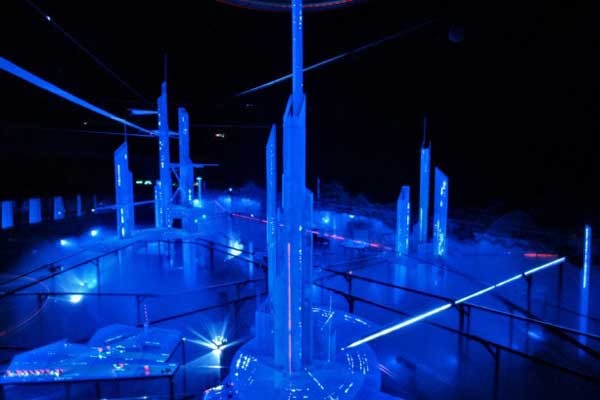
Speeding to the Future!
The next step in our journey is the speed rooms, which create a convincing feeling of movement. Also used effectively in the Disneyland People Mover and If You Had Wings, they’re only present today in Buzz Lightyear’s Space Ranger Spin at Walt Disney World. The large screens give the sensations of zooming down a bobsled track and flying off a mountain top. Our next room takes us through swirling fire and other effects. We also enter the computer world of TRON, also released in 1982. It’s a pretty simple device yet can be thrilling with the right approach.
The finale reminds us that yes, we are in Future World. CenterCore is a large vision of a futuristic city of bright lights in a mostly dark room. While grand music plays in the background, we dream of wonders to come. How long do I have to wait for this future? There is one last touch that I loved as a kid before we disembark. The quick shot of riders sitting inside a futuristic car through the Pepper’s ghost effect was cool in the ‘80s. In fact, it’s still amazing today. Sometimes a simple effect can work wonders. Our journey has ended, but there is still more to see in the TransCenter.
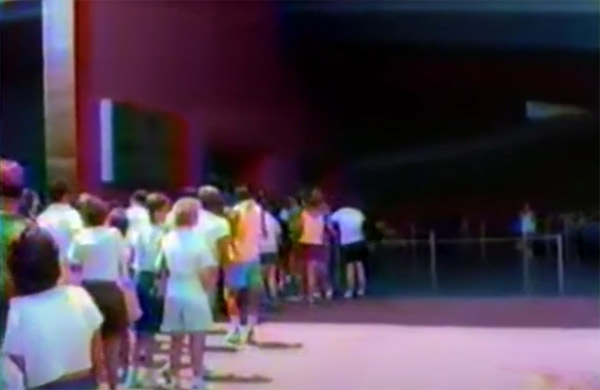
Popularity Questions
Looking back at World of Motion has me thinking more about today’s narrative. Demand at the parks is extremely high. Lines are out of control, so we need FastPass Plus to fix it. On the other hand, we could draw a line back to the loss of World of Motion, Horizons, and others to explain some of the issues. When you replace a ride that handles 3,000 guests an hour with one that carries far fewer, it makes a definite impact. When that switch is made in multiple places along with a reduction in total attractions, the remaining attractions build an artificially higher demand.
I’m not making the case that World of Motion was a big draw in its later days. However, the huge capacity did make it seem emptier than it really was. EPCOT Center was built to handle massive crowds. After the initial surge, the park didn’t maintain the pace. EPCOT’s attendance has been relatively flat for decades. According to an LA Times article from December 1998, Epcot attracted 10.6 million guests in 1998. In 2019, it drew 12.4 million. Lines are partially due to capacity, not just higher crowds.
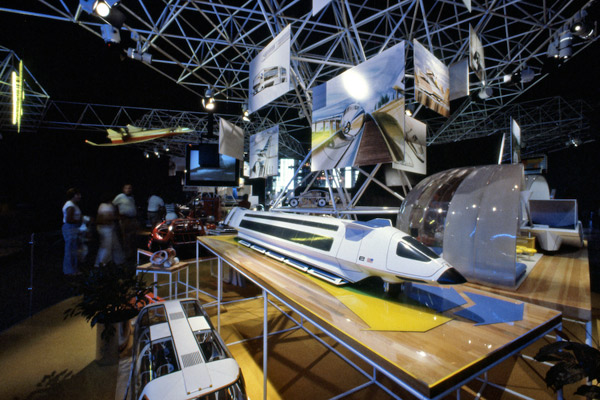
A Treasure from a Bygone Era
World of Motion used all of Disney’s best tools available in the early ‘80s. It includes complex scenes filled with sets and animatronics, a massive futuristic city, and speed rooms to provide some excitement. When you add in a memorable tune and fun narration, the mix works amazingly. The post-show TransCenter also is a lot more than just a GM showroom. It all remains strong when viewed online many years later.
Will Disney build another giant attraction featuring Audio-Animatronics? They did create Star Wars: Rise of the Resistance, but that feels like an outlier given its cost and time. More should follow the mold of shorter thrills from Seven Dwarfs Mine Train or Radiator Springs Racers. In those cases, the modern animatronics complement the excitement and add extra touches to high-speed attractions.
When the World of Motion closed in January 1996, it signaled the unofficial end of an era. Horizons had been closed (though it would return for a few years), and Ellen’s Energy Adventure was coming soon. CommuniCore had also changed into the much louder and less original Innoventions. It was the beginning of a shift to the mix of themes we see today. EPCOT has added strong attractions (including Test Track) but feels less cohesive. World of Motion fit the classic Disney attraction into a new mold. It’s part of a different era and is still missed. Like so many other extinct gems, it lives on through tribute sites, online videos, and our memories.
For additional information, check out the page dedicated to Lost EPCOT. It offers lots of great details about this attraction and its creation.
This post contains affiliate links. Making any purchase through those links supports this site. See full disclosure.



Love your articles.
Thanks Richard! I’m glad you’re enjoying them.
Hello Dan,
I just found your site. It’s wonderful. My first memory is similar to yours because it is also of the Polynesian. However, for me, it was my honeymoon in 1979. You are indeed an old soul and wonderful at description. Sadly, the next time I was at Disney World was in October of 1983 and I don’t recall riding ‘World of Motion’. It would surely have been a ride that I would have enjoyed. I am so sad that I missed it. The next time we went to Disney World, was when we started to take our daughters, which was May 1996. Guess it was just not meant for us to ride “World of Motion’. But we did get to ride ‘Horizons’ before it finally closed. We loved it! Thanks so much for this site.
Thanks Rosane; I really appreciate the kind words. I suspect you may have just missed World of Motion when you visited in 1996. It closed around that time to make way for Test Track (which didn’t open until 1999). It’s great that you got to ride Horizons on that trip; I also rode it around the same time in 1998 before it closed. It’s too bad that you weren’t able to see World of Motion in 1983. It was quite popular in the early days, so it’s possible it had a long line. I’m glad you’re enjoying the site!
Ahhh, World of Motion, what a delightful memory. It was fun to take a look back at this old-school jewel of EPCOT. It’s a shame that no video I’ve seen really captures the scale and beauty of that final futuristic scene- it’s just too dark and home movie cameras weren’t great at the time. It was a stunning and unexpected finish that rivaled the climax of Spaceship Earth.
Just one little error in your article, Dan– in the EPCOT ride times you mentioned Flight of Passage, I suspect you meant Soarin! Close enough!
It really was a gift to have been born in 1975, as I got to experience the older Disney/EPCOT rides, and witness the development of video games and evolution of music from record to eight-track to cassette to CD to digital. Sometimes my life feels like my own personal carousel of progress. I’m guessing you’re about the same age, Dan! A toast to us middle-agers!
Melanie, I’m right with you on the final scene. I think World of Motion closed a bit too early for cameras to really capture it well. A lot of the best videos of Horizons or Imagination were probably from their last runs in the late ’90s. Also, I think the futuristic city was just difficult to capture like you mention due to its size and the lighting. It was really impressive! Thanks for catching the error. I just fixed it in the article. In terms of age, I was born in 1976, so I’m right there with you! Thanks.
I have the design pictures with a Walt Disney copy right stamp from 1979
That’s awesome! I know that World of Motion was one of the first pavilions that was more set in stone early on and even during 1982.